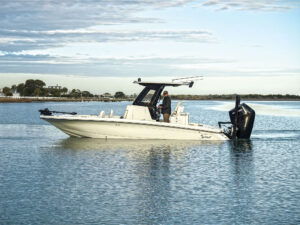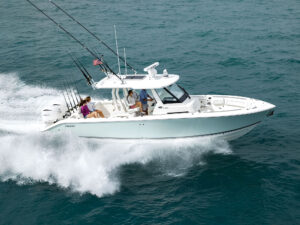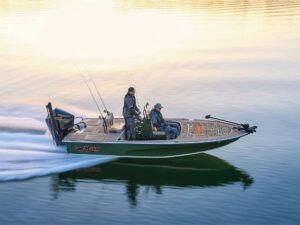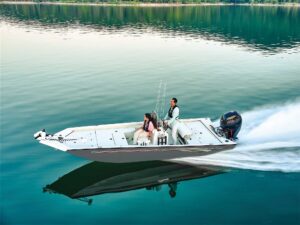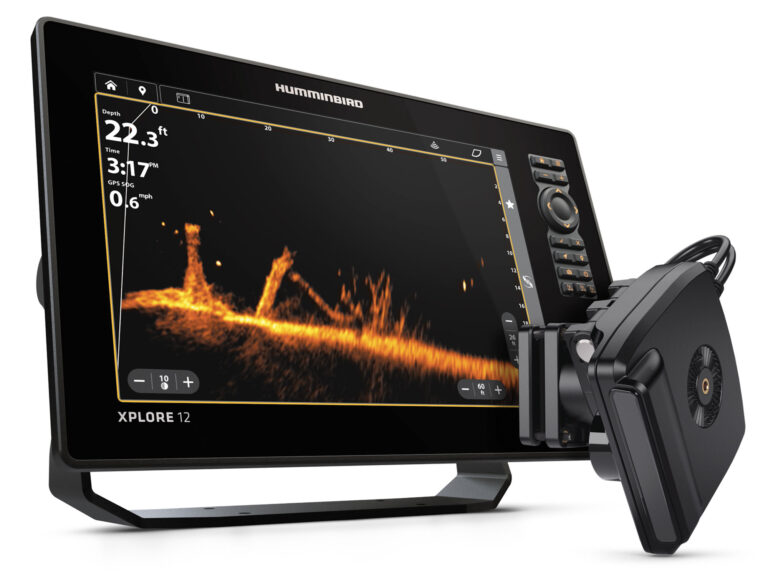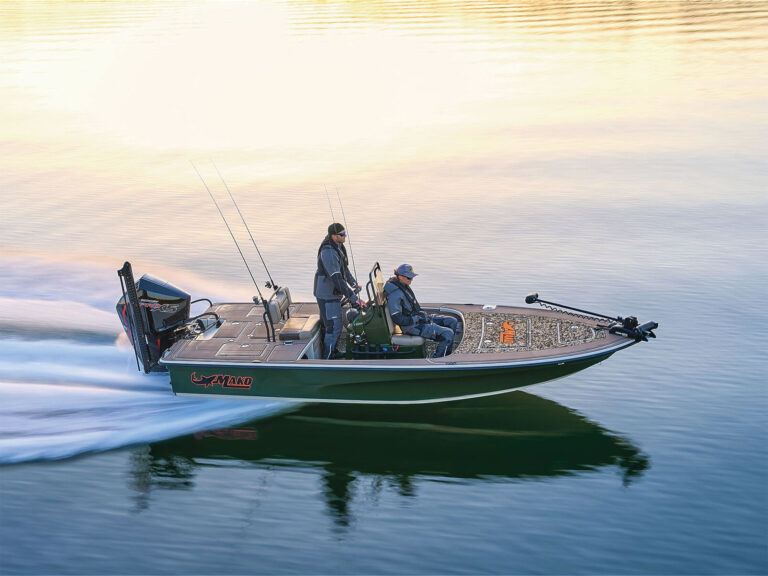We had to ride a long way to get after the fish. But this was by choice. My brother and I prepared for our trip, taking us from the south shore of Long Island around Montauk and up to Newport, Rhode Island, by packing four days’ worth of food, foul weather suits, a ridiculous amount of fishing gear, sleeping bags, water, ice — you name it. We finished packing the boat and noticed something — aboard the Trophy 2503 Center Console, we had room for a lot more.
Key to the massive stowage possibilities was the large leaning post. The cushioned seating unlatched to flip forward, revealing a gigantic dry stowage bin that could hold a healthy allotment of gear. Flipped down, the seat could serve as a leaning post or seat with the backrest and footrest deployed. A pie hatch to port of the stainless-steel wheel served as a good place to keep the cell phone and car keys.
With all this dry stowage, we never worried about getting wet unless it rained. The high freeboard and wide bow flare deflected spray down and away from the cockpit, keeping us from getting soggy even as the conditions grew rougher. The experiences from this trip, as well as many others, proved that the 2503 is an able and worthy offshore center console.
Geared Up
Trophy is known for its ability to build a good fishing boat at a good price. And our 2503 CC proved no exception. For the base boat paired with our twin 200-hp Mercury OptiMax outboards, the price comes out to $70,802. Compare that to the Boston Whaler 240 Outrage, a slightly smaller boat at 23’9″-by-8’6″ with a 150-gallon fuel tank, which sells for $98,252 with twin 200-hp Mercury Verados. The Cobia 256, which sells for $81,314 with twin Yamaha F150 four-stroke outboards, is more in line on the retail sticker.
Our 2503 CC came equipped with an impressive list of options that push it up into the next price bracket. Start with the Pro Pack ($1,329), which includes the 25-quart removable bait cooler, bait cutting board, coaming bolsters, leaning post backrest, raw-water washdown, and Northstar 710 VHF radio. The 2503 CC also came with the pressurized freshwater system, cushion package, forward table, stereo, pumpout head, offshore blue gel coat, leaning post with rocket launchers, windlass, Northstar 650 GPS, outriggers, and hard T-top with spreader lights. All these goodies brought our test boat price to more than $86,000.
The aforementioned leaning post proved to be one of the feature highlights. The forward cockpit table was another. Leave it recessed and the table, a fiberglass insert with molded-in nonslip, forms an elevated casting platform with the U-shaped bow seating. If the fishing’s dead and it’s family time, snap in the bow cushions and the platform becomes a sunpad. If the fishing’s been good and it’s time for sushi, release the hydraulic lift on the table base. It springs up to form a dinette capable of seating four.
The polyethylene-lined head inside the console is spacious enough for two adults to stand fully upright, which is great for privacy purposes but even better for access to the dashboard panel and wiring. Our boat came with the Northstar 650 GPS, but should you go with your own electronics, you’ll appreciate the wiring tubes and preinstalled string that acts as a snake to bring wires through the T-top supports. Had we done it ourselves, we would have mounted the GPS antenna on the hardtop rather than atop the console, where it sometimes lost its signal due to interference from the hardtop. The rigging behind the dash was neat and orderly and easy to follow for maintenance to the gauges.
A couple of things I’d like to see Trophy add: The optional windlass should have a chain stop to keep the anchor from bouncing and putting strain on the windlass drum. I’d also like to see a set of bow chocks or a centerline cleat to help with setting dock lines and anchoring. But overall, the 2503 CC’s well thought out layout and interior made it a great platform for heading offshore and for keeping down the distractions and annoyances while hunting fish.
Fishing Machine
My brother and I had intended to make it to Newport to pursue bluefin tuna, but halfway through our trip we got whacked by dense fog and deteriorating weather. We turned around and made it into the inlet just in time to encounter an epic striped bass bust. We changed gears from the offshore mindset to light tackle. In this inshore setting, the nonslip on the elevated bow platform helped us keep our feet while casting, and the wide space between the console and the gunwales allowed us to run around the boat chasing and fighting fish. And while fly fishing for false albacore, with one driving and the other on the bow ready to cast, we appreciated the recessed handrail at the bow, perfect for grabbing while crouching during run-and-gun maneuvers, but out of the way when the boat was at rest and we were casting.
But this boat is designed with offshore fishing in mind, so we put its big-game features to the test during the Hamptons Offshore Invitational tournament. The transom is set up as a bait prep station, with a built-in 30-gallon recirculating livewell that kept our baits lively on the 20-mile run from the inlet to the fishing grounds. To starboard of the livewell, Trophy installed a removable stowage tub that holds a 25-quart “bait cooler,” a good place to keep your frozen baits. The bait cutting board stows atop the bait cooler when not in use. When we were ready to start cutting up the mackerel and bluefish to start chunking for sharks, we attached the table to its preset fitting on the hatch and could cut bait and wash the scraps overboard with the raw-water washdown. The freshwater washdown is recessed in a notch to port of the livewell, so we could clean our hands and gear. The freshwater washdown hose reached well into the cockpit so we could give the dash a spray during cleanup.
When we hooked a big shark during the tournament, we appreciated some other fishy attributes, most notably the coaming bolsters that, with the high freeboard, came up to mid-thigh, and the stainless steel toerails recessed in the inwale rodracks. Had we landed a keeper mako or tuna, we could have boated it through the transom door. Two insulated 50-gallon fishboxes sit under the bow seats.
Sea Cruise
Of course, it doesn’t matter how well a boat is set up to fish if it can’t make it out of the inlet. The 2503 CC could get us offshore and back in moderate seas without incident. It has 21 degrees of deadrise at the transom, compared to a deeper-V center console with 24.5 degrees of deadrise and a sharper entry point such as the Contender 23 Tournament (25’3″-by-8’6″), which sells for $85,000 with a single Yamaha F250 outboard. The deeper-V is better suited for slicing waves, whereas a moderate-V such as the 2503 CC has better stability at rest and while trolling.
The 2503 CC isn’t a boat that pounds in rough seas. It performed better in a light chop at higher speeds, hitting its sweet spot at around 4000 rpm and 40 mph. The wide flare at the bow directs spray downward and outward, making for a dry ride. We did feel the boat lose some of its predictability at the helm at top speeds, possibly due to too much lift from the flared bow and hardtop.
During a time when four-stroke outboards get all the buzz, we enjoyed seeing how today’s two-stroke technology stacks up. Fuel numbers with our twin 200-hp OptiMax engines were excellent, on par with comparable four-strokes. Combined with our 163-gallon fuel tank, range was impressive. The low-end torque provided by two-strokes gave us great acceleration out of the hole and powered our climb to speed. Two-strokes are far noisier at idle and trolling speeds, and having to monitor oil consumption is a chore not needed on a day-to-day basis with four-strokes. But the 2503 CC’s remote oil fills on the transom made refilling the tanks easy. Fortunately, Trophy makes a lot of other aspects of owning and operating the 2503 easy, too.
Second Opinion
The Trophy 2503 CC has a clean finish and a functional layout. I especially like the leaning post with its cavernous stowage, plus its useful tackle stowage racks on aft side. Ya need that stuff. Integrating the cooler into the helm is a smart design, too. I’d hit a plumbing supply store and make a drain, since the provided cooler didn’t have one.
Kudos to Trophy for molding in copious nonslip, a necessity offshore, as is the self-bailing cockpit. Trophy placed the scupper outlets well above the waterline, even with twin V-6s installed. That made for quick water evacuation offshore and at the dock while cleaning.
I didn’t like the ride at speeds above 40 mph. The boat wouldn’t stay on its lines, tending to slew side to side. I’d say it has too much lift. There’s not enough hull left in the water to stay straight at higher speeds. The culprits could be too much horsepower, too much prop pitch, the engines being mounted too high (they were in the third mounting hole of four, so they can be dropped a bit), or a combination thereof.
I also didn’t like the “spotlight” that illuminates the switch panel. This little LED comes on when you turn on your navigation lights, illuminating the switches from below and the side. This creates glare and causes shadows from the switches, which make the panel tough to read. Install a backlit panel, please.
The 2503 CC had a few unexpected surprises for a boat at this price point. Most notable was the through-bolted hull-to-deck joint visible in the transom area — I would have expected screws. This holds up far better under repeated offshore pounding.
The windshield on the center console is supported by a powder-coated aluminum frame; it’s not some flimsy piece of screwed-in plastic. Under the console, access to the electronics panel and T-top for wiring and rigging is excellent.
EXTRA POINT: The extra pie-hatch compartments in the optional leaning post make for even drier stowage inside a dry-stowage area.

